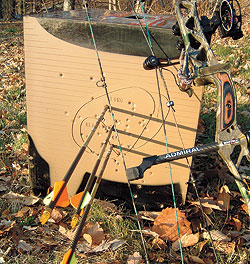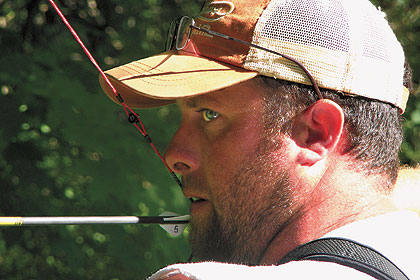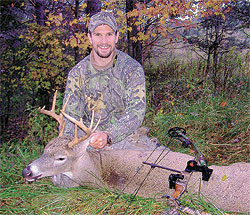October 28, 2010
By Christian Berg
Improving accuracy through psychology.
By Christian Berg
Peyton Manning plays football in it. Tiger Woods plays golf in it. LeBron James plays basketball in it. And you should be bowhunting in it.
It is "The Zone," a state of intense focus free of distraction -- a mental state that allows you to perform at your best.
Advertisement
Oh, sure, you don't have the physical skills of a world-class athlete, but that doesn't mean you can't benefit from using the same mental training techniques that took them to the next level. As Hall of Fame catcher Yogi Berra famously said, "Baseball is 90-percent mental. The other half is physical."
The same could be said of bowhunting. When it comes down to it, there isn't much difference between trying to hit a game-winning home run in the ninth inning and making a perfect, double-lung shot on the buck of a lifetime. Both are fleeting, pressure-packed opportunities, and you've got to be at the top of your mental game to come through in clutch.
Advertisement
Head Games
Bryan T. Karazsia, an avid Pennsylvania deer hunter who holds a master's degree in clinical psychology from Kent State University in Ohio, said there is no doubt improving your mental discipline will improve your accuracy with the bow.
"The fields of clinical and sports psychology have proven that these [mental training] methods can enhance your performance in the field -- so much that the best athletes in the world have paid thousands of dollars to get some advice from a sports psychologist," Karazsia said.
 A perfect, double-lung shot on this year's trophy starts by visualizing that success during off-season practice sessions. By imagining the perfect shot -- and making it -- thousands of times in advance, you'll feel more confident and be able to focus not on antlers, but on exactly where you want your arrow to go. |
"The key is practicing not just the skill of shooting, but the skills of relaxation and focus. No matter€¦how great your equipment is, every single thing in hunting comes down to you. Can you make the shot when you must, and can you do it again and again, year after year?"
Karazsia said off-season mental practice is just as important as the physical practice done on the target range or 3-D course. Here's his program for sharpening your mental edge and making the most of your opportunity the next time Ol' Ten Point walks under your stand:
Imagine you're sitting in your favorite treestand. It's getting late in the season, and although you've seen plenty of whitetails, there's been no sign of that big 10-pointer you caught on your trail camera back in September. You've been sitting about four hours, wondering whether he's still alive, when opportunity knocks.
The moment Mr. Big walks into view, your body starts going haywire. Your heart races, your arms shake, your palms sweat and your breathing gets short. You may have practiced shooting all summer, but you didn't prepare yourself for this.
"Would you ever tell anyone to go to a hunting store, buy a [bow] and that day, take it out in the woods and hunt?" Karazsia asked. "Of course not, but far too often that's exactly what we're doing with our methods of relaxation. We don't practice and develop the skills of focus and relaxation during the off season."
 No matter how good your archery gear and shooting form are, accuracy depends on your ability to focus. Diligent practice on the target range should include careful attention to the mental side of your shooting game. |
'Focusing Is A Skill'
The process of killing that 10-point buck in the winter woods, Karazsia said, should have started months ago on the summer shooting range. Just as hunters are encouraged to make physical preparations such as shooting with the same clothes they'll be wearing in the field, you should be developing a mental mindset that will put you in "The Zone" when crunch time arrives.
The key, Karazsia said, is total focus. "Focusing is a skill. It is not just a natural ability," he said. "Just like any skill, we can get better at it."
Our ability to focus can be enhanced by visualizing that monster buck as we take practice shots and repeat all the little things -- such as standing up and raising the bow -- that could prove critical in the moment of truth.
Karazsia also recommends practicing slow, methodical breathing accompanied by a calm, soothing word repeated over and over in your mind. For Karazsia, that word is "ocean," and he uses it as a mantra when he feels buck fever overwhelming his senses. "When I think of ocean, my body just goes relaxed," he said.
The process of maintaining proper focus continues once hunting season arrives by concentrating on the task at hand and developing a selective memory that blocks out any negative thoughts that can erode confidence.
"When we are hunting, we have a lot of time to think," Karazsia said. "That can be a good thing or a bad thing. It's bad when we're thinking of that buck we may have injured a few years ago, or even last week. It's very good if we're increasing our confidence with memories of a successful hunt."
It also can help to go over a positive mental checklist of all the things that must be done when a shooter comes within bow range.
 Psychologist Bryan T. Karazsia doesn't just preach the importance of mental training -- he practices it. The Pennsylvania resident took this nice Indiana County 10-pointer during a recent archery season. |
"Take out anything in our minds that tells us what we should not do and replace it with the do," Karazsia said. "For example, if I'm thinking to myself, 'Don't make noise,' or 'Don't pull my trigger,' I'm thinking of the wrong thing. I need to replace those with dos. 'Do stay quiet,' 'Do think of where that deer is coming,' 'Do squeeze
my trigger slowly.'"
And, when a shooter buck finally shows up, the less you stare at the bone on his head, the better.
"Focus on vitals, not antlers," Karazsia advises. "As soon as you ID a shooter, look at nothing else other than where you want your arrow to go."
By employing these simple techniques, and practicing them until they become habit, you'll increase your odds of coming home with a trophy this season instead of a story about the shot that went astray.
